Despite being named after Shakespeare, the actor turned writer only owned 12.5% of the shares in the Lord Chamberlain’s Men company. His shares further diminished over his career, ending at just 7%. The Globe Theatre was designed to house up to 3000 people, from commoners to high society. The three-storey building was 100 feet (30 metres) in diameter with an open-air design – a real estate agent’s spin on not having a roof.
Globe Theatre London Private Guided Tours

Originally built by Shakespeare’s playing company in 1599, the Globe Theatre in London features plays both modern and old. Tragedy seemed to follow Shakespeare not only in writing, for the Globe Theatre burned to the ground in 1613 just 14 years after its opening. One year later, a second Globe Theatre was opened. It was shut permanently, however, 28 years later during the First English Civil War by Parliament Ordinance and converted into apartment buildings. It wasn’t until 1997 that the Globe Theatre would re-emerge via a modern reconstruction.

The first play ever performed in the Globe Theatre was Shakespeare’s Julius Caesar, but other playwrights, such as John Fletcher – whose fame rivalled Shakespeare’s at the time –, had their plays performed in the theatre. When it reopened in 1997, surprisingly, it was not one of Shakespeare’s plays first performed, and instead a German play. Shakespeare references the Globe Theatre in Henry V and The Tempest, meaning which is lost unless viewed at the Globe Theatre. Before the time of the internet, the only way to know which play was being performed was via flags hanging outside the theatre. Black flags referred to tragedies, red flags to history, and white flags to comedies.
Architecture
The Globe Theatre is a faithful recreation based on designs from 1599 and 1614 and allows visitors to feel what it was like to be alive during Shakespearian times. The current building was constructed about 230 metres from the original theatre. Although the exact size of the original building is unknown it's agree that it could house around 3,000 audience members and was a three-storey, open-air amphitheatre of about 30 metres diameter. Originally thought to be round, recent excavations suggest that it was in fact polygonal with 20 sides.
Uncover London's secrets and must-sees. Tailor your adventure, from majestic Westminster Abbey and Buckingham Palace to hidden pubs and Shakespeare's Globe. Witness the Changing of the Guard, stroll through Hyde Park, or take a ride on the London Eye. Experience the best of London, your way.
Chauffeur Driven Car
Theatre lovers, this tour is for you! Explore Covent Garden's sparkling mix of theatres and luxury boutiques, see its world-famous street performers and magicians and hear all about London's Theatreland.
Walking Tour with Public Transport
Harry Potter fans: this is the best tour you could have dreamed of! Meet a MAGICIAN-GUIDE, who will perform tricks as you're exploring London and Harry Potter's dealings with it.
Walking Tour with Public Transport
Whizz past London's icons in a luxury car! Buckingham Palace, Tower Bridge, St Paul's Cathedral-pack it all in on our custom drive-thru tour, perfect for short stays. Choose your theme-royals, parks, architecture, or even Harry Potter!
Chauffeur Driven Car
Discover the secrets of music in Soho, stunning art in the National Gallery and stories of London’s Theatreland in ONE DAY with a bubbly Blue Badge Guide and musician.
Walking Tour with Public Transport
Unlock London's secrets on a personalized city tour! Witness Big Ben, St Paul's Cathedral, Buckingham Palace, and hidden gems. Dive into history, traditional English pubs, and vibrant markets with your friendly local guide. Craft your London adventure today! Available as a 4, 6 or 8 hour tour.
Black Cab Tour with Walking Stops
Explore London's iconic sights like Big Ben & Buckingham Palace on a private, customizable tour with a friendly local guide. Discover hidden gems & secret pubs from Westminster to Borough Market. Your London adventure awaits! Available as 4, 6 or 8 hours.
Black Cab Tour with Walking Stops
See the iconic sights like Big Ben, Buckingham Palace, and the Tower of London, or venture off the beaten path to hidden gems loved by locals. Your experienced guide will tailor the tour to your interests, from history and art to food and local markets. Enjoy leisurely strolls, photo stops, and insider knowledge along the way. Available as 4, 6 or 8 hours.
Black Cab Tour with Walking Stops

 Book Tour
Book Tour


